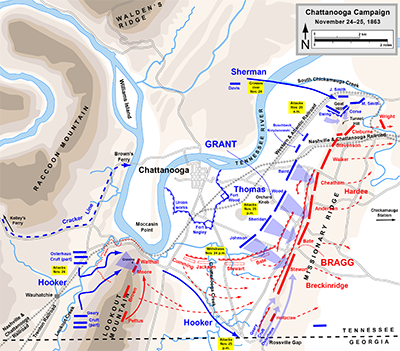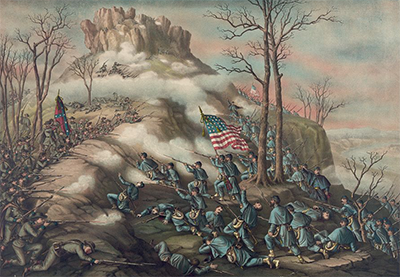The Battle of Chattanooga
The Battle of Chattanooga was a Union victory during the American Civil War. The result solidified the Union hold on the vital railroad junction and supply center and paved the way for further Northern invasions of the South. After the Confederate victory at Chickamauga in September 1863, the Union army under Gen. William S. Rosencrans retreated in haste to Chattanooga. Gen. Braxton Bragg and the Confederate Army of Tennessee followed and seized the high ground surrounding the city. Two of those heights were Lookout Mountain and Missionary Ridge. 
The presence of the Confederate troops surrounding the city of Chattanooga cut the supply lines for the Union troops occupying the city. It wasn't long until the Union army began to struggle to feed its troops. On Oct. 10, 1863, the overall commander in the West, Ulysses S. Grant, replaced Rosencrans as leader of the Army of the Cumberland with one of Rosencrans's subordinates, Gen. George Thomas, whose heroic stand in the previous battle had earned him the moniker the "Rock of Chickamauga." Grant told Thomas to hold the city at all costs while he, Grant, organized new lines of supply. Along with those new supplies came 40,000 troops, led by Joseph Hooker and William T. Sherman. Grant did so, with Union troops taking nearby Brown's Ferry, on the Tennessee River. Meanwhile, Bragg, content in his siege tactics, peeled off two his divisions under Gen. James Longstreet and sent them to Knoxville. Bragg sent more of his force out of the city, and on November 23, Grant decided to act. Union troops overwhelmed the Confederate defense on 100-foot-high Orchard Knob, giving the Union command a better view of the surroundings. Seeing this, Bragg concentrated his defense force on Missionary Ridge. The Confederate force on Lookout Mountain, which was near, Orchard Knob was slight. 
On November 24, Hooker led a three-division-strong contingent of men in an attack on 2,400-foot-high Lookout Mountain. The Confederate defenders had all the advantages of the high ground, but they did not at all have superior numbers. Their guns could fire only so often, and they had only so much ammunition. As well, a thick fog rolled in during the afternoon, blunting the counterattack ordered by Confederate Brig. Gen. John C. Moore. Hooker and his men eventually reached the top of the mountain and dispatched all of its defenders. Thus ended the so-called "Battle above the Clouds." Meanwhile, Gen. William T. Sherman was leading an attack on Missionary Ridge, or so he thought. Sherman's men actually seized another bit of high ground, Billy Goat Hill, and then met with enough resistance from the men of Maj. Gen. Patrick Cleburne at Tunnel Hill that they called off the rest of the attack. The following day, November 25, Thomas's men stormed a number of rifle pits that the Confederate defenders had dug on Missionary Ridge. The Army of the Cumberland halted to get organized but came under withering fire from elsewhere on the ridge. Thomas, without specific orders to do so, urged his men onward. They succeeded in taking control of the ridge and putting the Army of Tennessee to flight. Hooker and his men were advancing as well but played little part in the final victory. Casualties from the Battle of Chattanooga were relatively similar: the Union total of 5,824 included 753 dead, 4,722 wounded, and 349 missing; the Confederate total various by source from 6,000 to 8,000 and has no specific breakdown. |
|
Social Studies for Kids
copyright 2002–2025
David White




